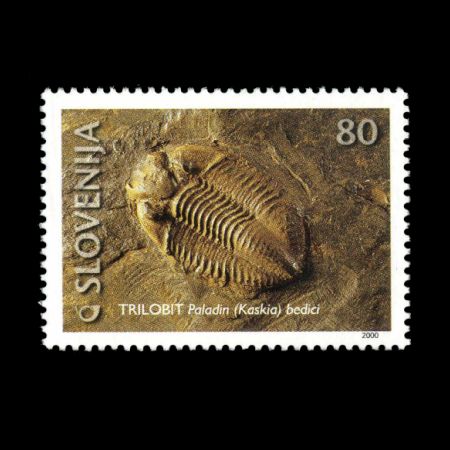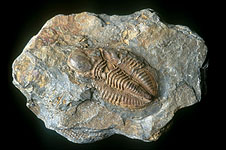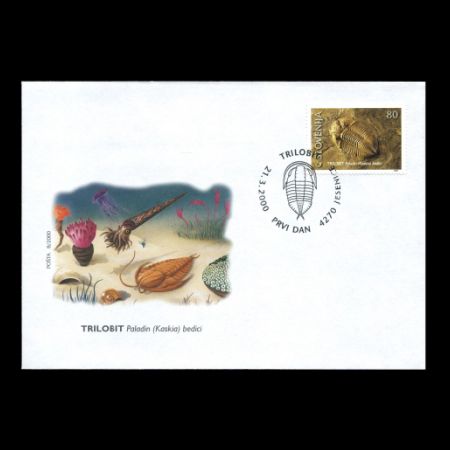Slovenia
2000
"Fossils - Trilobite"
| Issue Date |
21.03.2000 |
| ID |
Michel: 295 Scott: 397 Stanley
Gibbons:
444 Yvert: 269 UPU: N/A
Category: pF |
| Author |
Design: Matjaz Ucaka |
| Stamps in set |
1 |
| Value |
80,00 T. Trilobite |
| Size (width x height) |
28,80 x 40,32 mm |
| Layout |
Sheet of 25 stamps |
| Products |
FDC x1 |
| Paper |
Chancellor oba free L.S.PVA GMD 102g,
gummed
|
| Perforation |
14 |
| Print Technique |
4 color offset |
| Printed by |
DELO - TISKARNA d. d., Ljubljana |
| Quantity |
|
| Issuing Authority |
Posta Slovenij |
 Trilobite Paladin (Kaskia) bedici
Trilobite Paladin (Kaskia) bedici
Trilobites are a group of extinct arthropods.

The image is from
PMS
website
|
Their body was segmented into the cephalon (head), segmented thorax
(body), and pygidium (tail). Their back was covered with a hard
three-part chitinous skeleton divided into the head, thoracic and tail
shield. The trilobites bore a long central axis, or axial lobe, flanked
on each side by the lateral lobe. The exoskeleton (external skeleton)
was divided lengthwise into three prominent lobes, the medially located
axial lobe and two lateral pleural lobes (on each side of the body).
Trilobites were in the Palaeozoic
Era one of the most important and the most numerous animal
species. The oldest specimens appeared in the Early Cambrian Epoch,
about 520 million years ago and last ones died out at the end of the
Palaeozoic Era about 250 million years ago.
The trilobite species Paladin (Kaskia) bedici depicting on the stamp
lived together with two
other trilobite species and two subspecies on the territory of today's
Spodnje Pocivale in the Late Carboniferous Epoch, a little more than
290 million years ago and represented the most important Carboniferous
trilobite fauna in the Karavanke. Spodnje Pocivale in Javorniski Rovt
is a very rich collecting area of Late Carboniferous fossils where
several samples of the new trilobite species were found, among them the
whole exoskeleton. The species was described by Prof. Gerhard Hahn and
Renata Hahn from the Marburg University . At Anton Ramovs's suggestion,
the species was named bedici in honour of the Jesenice-native Joze
Bedic, who contributed a great deal to the very rich
trilobite collection from the Jesenice area.
The text above is from official press release of Posta Slovenij, written by Anton Ramovs
Notes:
Anton Ramovš (17 December 1924 – 1 May 2011) was a Slovene geologist and paleontologist, who
was born in Dolenja Vas near Železniki in 1924. He studied at the
University of Ljubljana and graduated in 1950 and obtained his
doctorate in 1956. He worked at the University of Ljubljana. His main
area of research was petrographic and geological mapping. He died in
2011.
He won the Levstik
Award in 1961 for his books Zemlja skozi milijone let and Geološki
izleti po ljubljanski okolici (Earth Over Millions of Years and
Geological Outings Around Ljubljana).
|
Jože Bedic (27. november 1923 - 15. februar 2002) was collector of
fossils and museums friend, who found the trilobit.
Bedic collection of fossils has about 20,000 specimens,
representatives of various animal groups. About 4,000 of it are
prepared. The major part of the collection is owned by Gornjesavski
Museum Jesenice that her best part since 1993 continuously provides on
display to visitors in Ruard manor house in Jesenice, a small part of
it is owned by Lady Anne bedic
|
Products
| FDC | |

|  |
References:
Posta Slovenije
Karavankona - the fossils of the Southern Karavanks,
Latest
update 05.12.2017
Any feedback, comments or even complaints
are welcome: [email protected] (you
can email me on ENglish, DEutsch, or RUssian)




